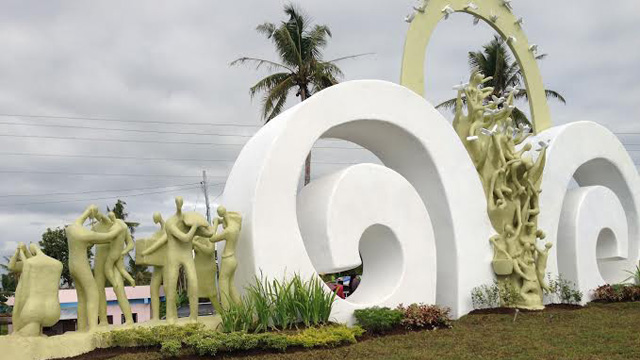Fiberglass monuments rising 12 feet in the shape of flaming candles are the New Stations of the Cross inside the Archbishop’s Palace compound in Palo, Leyte province.
The words inscribed there carry reflections on the devastation brought about by supertyphoon Yolanda in 2013.
Palo Archbishop John Du led the blessing of the markers and Mass on Holy Tuesday.
“They relate to our experience of Yolanda,” said Du. “We interpret our sufferings to sanctify ourselves.”
Called Leyte Stations of Pain, Grief and Arising, these were one of three memorials donated by Smart Communications in Leyte dedicated to the victims of Yolanda.

A memorial for victims of supertyphoon Yolanda rises in Tanauan, Leyte province designed by Davao-based artist Rey Mudjahid “Kublai” Millan. (Right) New Stations of the Cross made of fiberglass are turned over by Smart Communications to Palo Archbishop John Du. /Contributed photo
Symbol
The candle-shaped markers are a “symbol of hope which is appropriate fo the Holy Week,” said lawyer Jane Paredes, Smart Communications public affairs senior manager for Visayas and Mindanao.
The text in each marker was written by Redemptorist brother Karl Gaspar, CssR.
The markers were designed by Davao City-based artist Rey Mudjahid “Kublai” Millan.
Millan also created a roadside marker called the Surge of Hope, dedicated to storm victims of Tanauan town, where he lived in the community, listening to survivors’ stories of grief and hope.
The marker was turned over by Smart Communications to the municipality.

Storytelling
It stands by the roadside of barangay Calugkog, bearing names of storm victims who died during the disaster.
Local officials said it is a symbol of hope, resilience and recovery, a good topic for storytelling for generations to come.
Nearly two years after the supertyphoon, Leyte continues to recover, with ongoing repair work of roads, bridges and houses.
Lumber, gravel, and other construction materials can be seen piled along the road.
Foreign aid workers are still present, helping communities rise from the rubble.
Disclaimer: The comments uploaded on this site do not necessarily represent or reflect the views of management and owner of Cebudailynews. We reserve the right to exclude comments that we deem to be inconsistent with our editorial standards.




